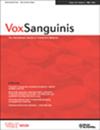Extending the post‐thaw shelf‐life of cryoprecipitate when stored at refrigerated temperatures
IF 1.8
4区 医学
Q3 HEMATOLOGY
引用次数: 0
Abstract
Background and ObjectivesThe post‐thaw shelf‐life of cryoprecipitate is 6 h, leading to high wastage. Storage of thawed cryoprecipitate at refrigerated temperatures may be feasible to extend the shelf‐life. This study aimed to evaluate the quality of thawed cryoprecipitate stored at 1–6°C for up to 14 days.Materials and MethodsCryoprecipitate (mini‐ and full‐size packs derived from both apheresis and whole blood [WB] collections) was thawed, immediately sampled and then stored at 1–6°C for up to 14 days. Mini‐packs were sampled at 6, 24, 48 and 72 h, day 7 and 14; full‐size cryoprecipitate was sampled on day 3, 5 or 7. Coagulation factors (F) II, V, VIII, IX, X and XIII, von Willebrand factor (VWF) and fibrinogen were measured using a coagulation analyser. Thrombin generation was measured by calibrated automated thrombogram.ResultsFVIII decreased during post‐thaw storage; this was significant after 24 h for WB (在冷藏条件下储存低温沉淀可延长其解冻后的保质期
背景和目的低温沉淀解冻后的保质期为 6 小时,因此损耗率很高。将解冻后的冷冻沉淀储存在冷藏温度下可延长保质期。本研究旨在评估在 1-6°C 温度条件下保存长达 14 天的解冻低温沉淀的质量。材料与方法将解冻的低温沉淀(来自无细胞采集和全血[WB]采集的迷你型和全尺寸包)立即取样,然后在 1-6°C 温度条件下保存长达 14 天。迷你包在 6、24、48 和 72 小时、第 7 天和第 14 天采样;全尺寸冷冻沉淀在第 3、5 或 7 天采样。使用凝血分析仪测量凝血因子(F)II、V、VIII、IX、X 和 XIII、von Willebrand 因子(VWF)和纤维蛋白原。结果FVIII在解冻后贮存过程中下降;WB(p = 0.0002)和无血球(p <0.0001)在 24 小时后显著下降。在解冻后第 14 天,所有无血细胞和 20 个 WB 低温沉淀中有 8 个符合 FVIII 指标(≥ 70 IU/单位)。纤维蛋白原在 48 小时内保持稳定,各成分在解冻后第 14 天均符合标准。在整个储存过程中,VWF 没有明显差异(WB p = 0.1292;apheresis p = 0.1507)。结论虽然解冻后冷冻沉淀中的凝血因子减少了,但解冻后的冷冻沉淀在冷藏温度下储存 7 天后符合欧洲委员会的规范。
本文章由计算机程序翻译,如有差异,请以英文原文为准。
求助全文
约1分钟内获得全文
求助全文
来源期刊

Vox Sanguinis
医学-血液学
CiteScore
4.40
自引率
11.10%
发文量
156
审稿时长
6-12 weeks
期刊介绍:
Vox Sanguinis reports on important, novel developments in transfusion medicine. Original papers, reviews and international fora are published on all aspects of blood transfusion and tissue transplantation, comprising five main sections:
1) Transfusion - Transmitted Disease and its Prevention:
Identification and epidemiology of infectious agents transmissible by blood;
Bacterial contamination of blood components;
Donor recruitment and selection methods;
Pathogen inactivation.
2) Blood Component Collection and Production:
Blood collection methods and devices (including apheresis);
Plasma fractionation techniques and plasma derivatives;
Preparation of labile blood components;
Inventory management;
Hematopoietic progenitor cell collection and storage;
Collection and storage of tissues;
Quality management and good manufacturing practice;
Automation and information technology.
3) Transfusion Medicine and New Therapies:
Transfusion thresholds and audits;
Haemovigilance;
Clinical trials regarding appropriate haemotherapy;
Non-infectious adverse affects of transfusion;
Therapeutic apheresis;
Support of transplant patients;
Gene therapy and immunotherapy.
4) Immunohaematology and Immunogenetics:
Autoimmunity in haematology;
Alloimmunity of blood;
Pre-transfusion testing;
Immunodiagnostics;
Immunobiology;
Complement in immunohaematology;
Blood typing reagents;
Genetic markers of blood cells and serum proteins: polymorphisms and function;
Genetic markers and disease;
Parentage testing and forensic immunohaematology.
5) Cellular Therapy:
Cell-based therapies;
Stem cell sources;
Stem cell processing and storage;
Stem cell products;
Stem cell plasticity;
Regenerative medicine with cells;
Cellular immunotherapy;
Molecular therapy;
Gene therapy.
 求助内容:
求助内容: 应助结果提醒方式:
应助结果提醒方式:


